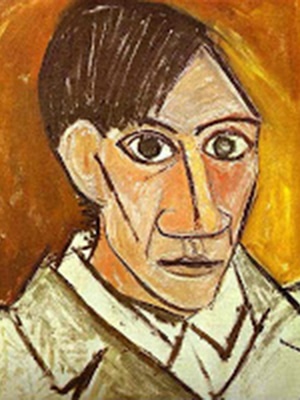Pablo PicassoSynthetic cubism was the later period of the Cubist art movement generally dated from 1912 – 1919. Artists of Synthetic Cubism moved away from the multi-perspective approach of Analytical Cubism in favour of flattened images that dispensed allusions of the three-dimensional space. Pablo Picasso, Clarinet, Bottle of Bass, Newspaper, Ace of Clubs (2013) The approach of the analytical phase was More (1881–1973), was a Spanish painter, sculptor, graphic artist, and resident in France from 1904. He was a dominant figure in avant-garde movements in the first half of the 20th century due to his technical versatility and prolific inventiveness.

Picasso’s progression in his early work is largely categorized by predominant colour schemes: His Blue Period (1901-1904) features motifs from everyday Parisian life, followed by the more lyrical Rose Period (1905–1906). Subsequently, Picasso transitioned to the avant-garde Cubist art movement, that he founded together with Georges Braque in France among others. In CubismSynthetic cubism was the later period of the Cubist art movement generally dated from 1912 – 1919. Artists of Synthetic Cubism moved away from the multi-perspective approach of Analytical Cubism in favour of flattened images that dispensed allusions of the three-dimensional space. Pablo Picasso, Clarinet, Bottle of Bass, Newspaper, Ace of Clubs (2013) The approach of the analytical phase was More, picture elements are broken into pieces and then rearranged in an abstract manner. The Cubist movement fundamentally changed the face of European paintingPainting is a fundamental form of visual art that has been practiced for thousands of years. It involves applying pigment to a surface such as canvas, paper, or a wall. Painting can be explored through various styles, techniques, and mediums, each offering unique possibilities for expression and creativity. Historical Background • Ancient Beginnings: The history of painting dates back to More and sculptingSculpting is a captivating art form that involves shaping materials into three-dimensional forms. This practice has a rich history and includes various techniques and materials, each offering possibilities for artistic expression. Historical Background • Ancient Origins: Sculpting traces back to prehistoric times with early examples like the Venus of Willendorf, a small figurine carved from limestone. These early works often More styles and further impacted music, literature, and architecture. It further inspired further art movements like DadaDada was an avant-garde art movement formed in the early 20th century in Zürich in reaction to the horrors of the First World War. The Dada artists believed that the war called into question any aspect of their society including the creation of art, therefore aiming at the demolition of traditional artistic values. On this basis, a new form of More, ConstructivismConstructivism is a revolutionary art movement that originated in Russia in the early 20th century, right after the Russian Revolution. It's a term that captures an entirely new approach to art and architecture, distinguished by its devotion to modernity, functionality, and the embrace of technology and industrial materials. Constructivism marks a bold departure from the art for art's sake philosophy, More, Futurism in other European countries.
